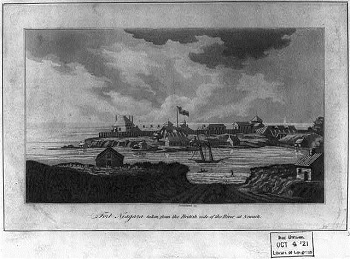Despite the animosity between their countries, American and British commanders found reasons to negotiate a temporary peace, providing both time to reorganize and resupply.
“I propose a further continuance of the armistice indefinitely”
- American commander to British commander, October 18, 1812

William Strickland, Fort Niagara Taken from the British Side of the River at Newark, Etching, 1814, Library of Congress.
Even in the middle of the war, commanders on both sides frequently found reasons to make temporary peace with the enemy. Though their countries were at war, American and British commanders usually maintained a polite, often gentlemanly, discourse between battles. In some cases, commanders preferred an armistice over unnecessary fighting.
One such respite occurred early in the conflict. In July 1812, Sir George Prevost learned that the British Parliament announced a change in some of its policies—policies that had frustrated the U.S. government. Prevost immediately requested an armistice from the American commander, General Dearborn. The British commander hoped that the change in policy would satisfy the Americans and bring a quick end to the war.
Initially, Dearborn agreed to the armistice, but President Madison rejected the offer, and the war continued. Officially, the first armistice of the war lasted only seven days, but on the frontier the peace held for eighteen days while letters traveled the country.
In October 1812, leaders declared a second armistice following the Battle of Queenston Heights. American forces had attempted to invade Upper Canada. Although the American troops gained an initial foothold, British reinforcements counterattacked and captured the American invaders. Major-General Isaac Brock fell mortally wounded during the battle, leaving the British forces in disarray. Brock’s successor requested an armistice for three days so that British forces could hold a funeral for Brock and send wounded Americans back across the river.
Neither army was ready for another fight after the losses and confusion of the battle. Both sides agreed to extend the armistice to six days. Finally, an American general declared, “As I am averse to taking a single life or occasioning a single calamity without an object, I propose a further continuance of the armistice indefinitely.”
The armistice ended on Friday, November 20, 1812 after thirty-eight days of peace. On Saturday morning, soldiers exchanged cannon fire over the Niagara River. The war, it seemed, was back on.
Last updated: May 24, 2016
